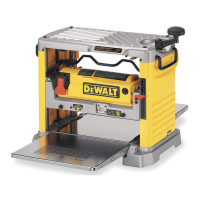ENGLISH
9
material is feeding out. Personal injury and/or
damage to the work piece mayoccur.
WARNING: This tool is designed to plane only wood.
Do not try to plane materials other thanwood.
WARNING: Never plane wood which is shorter than
12" (304.8mm) inlength.
WARNING: Plane only wood that is free from foreign
objects, with no loose knots and as few tight knots as
possible. Do not plane wood that is severely warped,
twisted, knotted orbowed.
WARNING: Do not feed wood across the grain,
always feed wood in the direction of the woodgrain.
NOTE: For best results, plane both sides of the workpiece
to reach a desired thickness. For example, if you need to
remove 1/8" (3.2 mm) from your workpiece, remove 1/16"
(1.6 mm) from each side. This not only allows the workpiece
to dry with a even moisture content, it also produces
finercuts.
NOTE: Always plane in the direction of the grain.
Planing material less than 3/4" (19.0 mm) wide is not
recommended. If you must plane narrow material, group
the pieces together and plane them as one wide workpiece
wheneverpossible.
Minimum/Maximum Width/Height/Depth (Fig. N)
NOTE: There is a certain area on the carriage of your
planer that will allow the 1/8" (3.2 mm) depth of cut on
material less than 6" (152.4mm) wide. See FigureN for an
approximate location of this area. Your material must move
under this section of the carriage or planer will not take
a 1/8" (3.2 mm) depth of cut. If the material is wider than
6" (152.4 mm), it will not fit through this area with an 1/8"
(3.2mm) depthcut.
Fig. N
Snipe
Snipe is a depression made when an unsupported end of
your material bends downward, causing the opposite end
to lift up into the cutterhead. If you are planing material that
is especially long, the use of additional material support
isrecommended.
To Avoid Snipe
Feed the workpiece into the planer so it is level and remains
flat against the base at alltimes.
Keep long workpieces level throughout planing operation
by receiving or “catching” them from the rear of theplaner.
WARNING: Do not place your body between the
workpiece and a stationary structure while the
material is feeding out. Personal injury and/or
damage to the work piece mayoccur.
Twisted, Cupped and Bowed Wood
If both sides of your material are very rough or if the material
is cupped, bowed or twisted, the planer may not produce
the desired result. Ideally, you should have at least one
level face/surface on your material before you plane. Your
thickness planer will work best with material that has been
run through a jointer to produce one flat surface. If you
do not have at least one flat surface or a jointer, see the
following recommendations:
To Plane Twisted Wood (Fig. O–Q)
WARNING: TWISTED WOOD MAY JAM YOUR
THICKNESS PLANER. IF A JAM OCCURS, TURN THE
POWER OFF, DISCONNECT THE POWER SUPPLY AND
RAISE THE CARRIAGE TO RELEASE THE MATERIAL
FROM THE CUTTERHEAD
To Plane Only Slightly Twisted Material
Plane both sides alternating from one to the other until the
desired thickness isreached.
Fig. O
To Plane Cupped Wood (Fig. P)
To obtain the best possible results with cupped wood:
Rip the material down the middle and plane it as two
separatepieces.
Fig. P
NOTE: Ripping the material reduces the severity of the
cup and allows the machine to deliver better results. More
material will be removed on cupped wood to achieve the
desired thickness than on a normalboard.
If Ripping the Material is not an Option
Plane one side of the material until flat, then plane the
opposite side untilflat.
TOP FLAT
BOTTOM FLAT
Fig. Q
NOTE: Do not flip the board back and forth between each
pass as recommended by the general planingdirections.
To Plane Bowed Wood (Fig. R)
The feed rollers and cutterhead in your planer will push
the bow out of the material as it feeds. When the material
exits the planer, the pressure of the rollers and cutterhead

